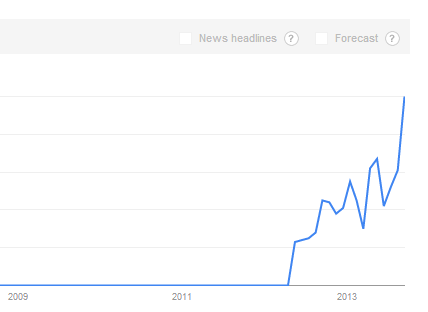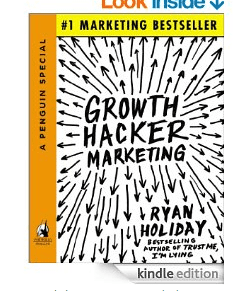Growth Hacker Marketing Report by Ryan Holiday - Book Review covering 4 key areas of focus for Growth Hacking
A little while back Dave Chaffey asked in a Smart Insights post, "What can businesses learn from growth hacking". This post introduced the Growth Hacking approach and how it originated in startup online businesses and explained how more traditional businesses are creating growth hacking roles to support conversion optimisation.
In this post, I'm adding more depth through a review of a Growth Hacking book I've been taking a look at recently. In Growth Hacker Marketing, Ryan Holiday explains more on this new approach which is being applied from the in the marketing departments of the smallest businesses to the largest blue-chip organisations. It prompts questions about how traditional marketing departments operate. According to Google Trends, the rise in searches associated with this new skillset is on the rise, could it be here to stay?

So why has Growth Hacking become a disrupter for how present and future organisations operate? I think it's two-fold:
- 1. Goodbye Industrial economy, Hello connected economy
The era of the Industrial Revolution and how many organisations (and their cultures) operate is in a steep decline. In its place is the connected economy which has provided the stimulus for collaboration and the initiative to tear down what were 'barriers to enter markets' and the destruction of monopolies (e.g. music industry, book publishing).
- 2. Impact of the Global Recession
The realisation millions of people and thousands of companies are waking up to in this new era is that we now live in a new dawn of an inter-connected, global economy. It's becoming easier to find a cheaper way, a cheaper alternative to race to the bottom. According to business magazine, Forbes: 'around 8.4 million jobs in the US disappeared from Jan 2008 to December 2009' - due to employees lacking digital skills or there simply was not the opportunities or requirement for traditional skills within companies.
This is further emphasised in the book, Graceful, 'Modern society is based on a modern idea: get the work done by replaceable cogs, by individuals programmed to do what they’re told, follow instructions and work cheap. The attraction of this system is evident by how easily ordinary organisations replace ordinary employees'.
Growth Hacker Marketing Overview
In his book, Holiday sets the scene by providing an overview of organisational culture and the waking up to the connected economy, listing a number of successful organisations that have embraced this way of work (Dropbox, Mailbox, Twitter, Facebook, Instagram) with a number of fascinating in-depth case studies through-out the book.
Four sections of the Growth Hacker E-book
The book is divided into 4 key areas: Product Market Fit, Finding Your Growth Hack, Going Viral & Retention & Optimisation 
- Step 1 - Product Market Fit (PMF)
PMF is the moment when the product and its customers are in perfect sync with each other. And the best way to get to this end goal is by starting with a minimum viable product and improving on it based on feedback - don't be afraid to launch the product and to learn from your audience on ways to improve its value, embrace the fear. In a by-gone era products were the responsibility of the product or business development team but PMF calls on the marketing team to now be a central component in the development and refinement of product creation and launch through listening to your audience e.g. setting up a blog, creating usability testing, conducting interviews - engage with your audience, learn from them.
- Step 2 - Finding Your Growth Hack
Know your audience; this is essential to make your audience aware of the product/service you're launching. The understanding of who your audience is, how they interact through digital and make them aware of your business - these are the key attributes required. You are looking to pull your customers in through a cheap, effective and unique way. Take
Dropbox for example: To launch the product the founders crafted a demo video to explain how to use the service. But rather than hire an expensive production company, Dropbox filmed the video themselves and knew where to post the video (i.e. where their prospective audience would be) by posting it on Digg, Slashdot and Reddit.
Growth Hacking is about launching your product as cheap as possible in a unique and differentiated way to your competitors and spreading virally is a central component to this i.e. you are relaying on your users to help spread the word. Everyone wants to launch the next viral ad to spread their product or service but are you making it easy for your product/service to be spread and more importantly, is it even worth talking about?
Dropbox built one of the most effective and most viral referral programs of the start-up world - the offer it put together was for its users who would receive 500 megabytes of free space for every friend they invited and got to sign up. By introducing this offer, sign-ups to Dropbox increased by 60% with more than 2.8mn direct invites a month.
- Step 4 - Retention and Optimisation
In traditional marketing, it is the marketer to bring in the leads and potential customers.
In the world of growth hacking marketing it's the marketers responsibility to retain, understand and interact with your potential and converted customer through the use of analytics.
Rather than throwing more and more money at external lead generation, the focus is on internal optimisation i.e. where can you increase your conversion to sale rate by 5%, how can you increase your click-through rate from an email campaign? The role of the growth hacker is to optimise incoming traffic and focus on retention.
Download Expert Member resource – Growth Hacking Guide
This guide aims to show how growth hacking concepts can be applied to established medium and large businesses as they seek to develop more agile marketing approaches. Naturally, the checklists in this guide will also be useful for start-up and smaller businesses.
Access the Growth hacking guide
Growth Hacking - It's here to stay
This is a book I would definitely recommend to anyone either working for a corporate business or working by themselves, it's a book that resonates perfectly with the connected, digital economy we are all operating in and more importantly provides you with a four step guide in the key attributes to consider to apply growth hacking techniques for marketing. As Author Thomas Friedman stated in his book, The World Is Flat,
'..around the year 2000 we entered a whole new era - Globalization 3.0 - which is shrinking the world from a size small to a size tiny and flattening the playing field at the same time'. Friedman goes onto refer to Globalization 1.0 as 'countries globalizing' and the dynamic force in Globalization 2.0 was 'companies globalizing', the dynamic force in Globalization 3.0 is the' new found power for individuals to collaborate and compete globally'.
This is why I think Growth Hacking is here to stay

Thanks to Simon for sharing his advice and opinions in this post. Simon Swan is a digital marketer who has led and built commercial marketing strategies for start-ups and large organisations working in entrepreneurial private sector and public sector environments.. You can
follow Simon on Twitter or read his
blog.





 Thanks to Simon for sharing his advice and opinions in this post. Simon Swan is a digital marketer who has led and built commercial marketing strategies for start-ups and large organisations working in entrepreneurial private sector and public sector environments.. You can
Thanks to Simon for sharing his advice and opinions in this post. Simon Swan is a digital marketer who has led and built commercial marketing strategies for start-ups and large organisations working in entrepreneurial private sector and public sector environments.. You can 


